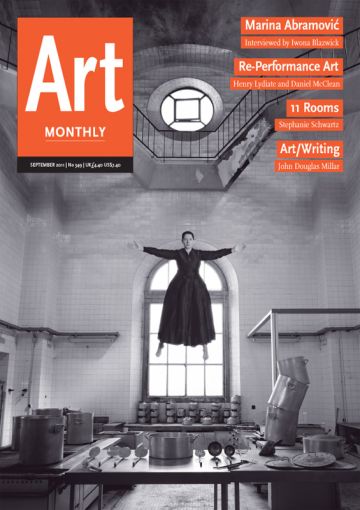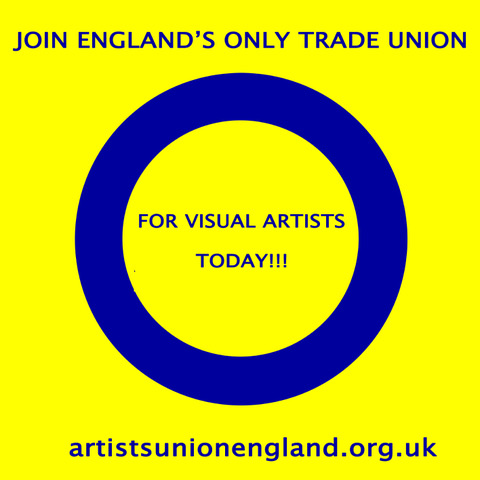Feature
Art/Writing
John Douglas Millar on why experimental writing thrives in the art world
Literature is like phosphorus, it shines with its maximum brilliance at the moment when it attempts to die.
– Roland Barthes Writing Degree Zero 1953
‘It is quite unusual now for a novelist to be very involved in contemporary art, and vice versa,’ the artist and novelist Tom McCarthy said in a 2009 interview with The Believer, ‘but look back to the futurists for example ... what Marinetti did, regenerate writing by hurling it, dragging it through the whirling blades of cinema and mechanical reproduction.’ A cursory glance at the current list of top-selling fiction titles suggests he is right about the difficulty of finding contemporary novelists who engage with the concerns of contemporary art. As chairman of his semi-fictitious art group the Necronautical Society, McCarthy is a high profile example, but he is a lonely one. As he suggests, in the era of high modernism the relationship was acknowledged and fruitful: Picasso’s productive relationships with Guillaume Apollinaire, Gertrude Stein and Ernest Hemingway; the literary triumvirate at the heart of the surrealists, André Breton, Georges Bataille and Jean Cocteau; and the constant manifesto making of the dadaists and futurists.
The recently published letters of Samuel Beckett reveal a passionate and intellectually sophisticated engagement with modern painting, while his friendship with Alberto Giacometti led to the sculptor fashioning the only prop – a white tree with a single barren leaf – for an early production of Waiting for Godot. Later, the artists’ writer du jour William Burroughs became an ardent collaborator with Brion Gysin and crossed directly into the visual field with his own bullet paintings. In fact Burroughs’s work was always more in tune with what was happening in contemporary art than in publishing – his cut-ups (Reviews AM338) and fold-overs owe more of a debt to surrealist collage than to Gustave Flaubert or William Faulkner. His influence on artists, from COUM Transmissions to Karl Holmqvist, is undeniable.
One reason suggested for this apparent forking of paths in the era of postmodernity and beyond is the inherent conservatism at the heart of contemporary publishing. In the same interview McCarthy is quoted as saying: ‘In the current climate in the UK publishing is a very conservative field. Editorial decisions are taken by marketing boards. There isn’t much room for something that isn’t middle of the road. On the other hand [you] can’t help noticing if you mix, as I do, with one toe in the publishing world and nine toes in the art world – it’s the artists who are extremely literate. In the current climate art has become the place where literary ideas are received, debated and creatively transformed.’ This description may be tainted with a hint of grass-is-greener dilettantism, but it is true that the history of avant-garde and experimental fiction and continental literary theory is embraced more fervently by the art world than it is in the world of contemporary literature, where it is now regarded as an elitist historical concern. Even Frank Kermode, who fought to bring theory on to the curriculum of literature departments in the UK, had pretty much renounced it by the time he died last year, saying it had become overly formulaic, a language to be learned and repeated rather than for generating original thought. It is often forgotten that what was once known as ‘literary theory’ has now been subsumed into the catch-all term ‘theory’.
One of the results for artists of the rise of critical theory, and the practice of close reading becoming fundamental and dominant concerns for fine art degree courses during the 1990s, was the gaining of an – at least – second-hand knowledge of the canon of European and world literature. The same period saw the rise and dominance in the publishing world of the MFA in creative writing; a programme that is firmly ahistorical in its approach. As Elif Batuman has written: ‘A limited historical consciousness is endemic to the discipline of creative writing, whose ultimate commitment is not to knowledge but to what Donald Barthelme called “not knowing”. [The] creative writing discourse still displays not a commitment to ignorance exactly, but ... a commitment to innocence.’
Literature and creative writing have become separate concerns, one continuing down the academic path of the comparative literature PhD, and the other into the creative writing MFA; one awards a Doctor of Philosophy, the other a Master of the Arts. So while academic and creative disciplines cross pollinate in the art world, they seem increasingly estranged in the literary world. The result is that the influence of experimental and avant-garde fiction waxes in the world of art while it wanes in the world of publishing. The works of Burroughs, Bataille, JG Ballard, Georges Perec, Jorge Luis Borges, Flann O’Brien and BS Johnson, anthologies of Imagist and concrete poetry, these can all be found on the shelves of the modern art bookshop but they get short shrift and have demonstrably little influence in the publishing world, where they are seen as difficult and unfashionable next to the dull tomes in thrall to the 19th-century realist novel (or po-mo variants thereof) that pepper weekend review pages.
So what are the consequences of this for art? What trends or symptoms can we delineate? The most startling is the rise of so-called ‘art writing’, as both a recognised practice and an academic discipline, and with it the growth in the market for the quasi-literary journal. F.R.DAVID, Dot Dot Dot, 2HB, The Happy Hypocrite, Cabinet and a wealth of other eccentrically named journals/magazines/collections/ catalogues/zines reflect a burgeoning interest in the written word – and not just the written word, but the word transcribed in a perishable material object, a book. The rise of this bibliophile tendency has come hand-in-hand with an increased interest in archive studies and it reflects a renewed Foucauldian concern with how knowledge is produced and logged, who owns and interprets it, and who speaks and on behalf of whom. It has also paralleled the rise of the internet, the blog and the portable digital reading device. The relative safety of the paper-bound book within contemporary art circles may suggest a negative reaction to the digitising of artistic production, a skewed romanticism where books are the final ruins of modernity, a Tintern Abbey for the digital age.
David Berridge describes a ‘diverse range of publications, but connected by some shared working principles: the form of a piece of writing is directly related to its content; new writing is always in relation with a sediment of previous texts; “writing” on the page is often inseparable with writing as script and event; “writer” is a shifting, uncertain engagement with the diversity of ways language operates in the physical, mental, and virtual environment’. What he is describing is the magpie editorial policies implemented by these publications. Picking up a copy of F.R.DAVID or the now defunct Dot Dot Dot, one is struck by the autodidactic nature of the selections. A sample from a graphic novel, an experimental theatrical script, an interview with an architect, a short skit by Mark Twain and a seemingly obligatory reference to Buckminster Fuller, for example, are all apparently caught under F.R.DAVID’s editorial policy: ‘Writing as a mode that informs and feeds, supports and describes, backs up and interprets, comments and reflects upon contemporary artistic production. Writing as “the core material” of a number of visual artists but equally as a mode that exists parallel to or in service of the visual.’ In other words anything at all.
There appears to be something liberating in this pick and choose approach, it seems to reject the heavily academicised world of curation where the need for a historical or thematic narrative is not just the job, but the justification for the job of curator. It seems to give the reader autonomy to interpret the selection as they wish. On the other hand this could be interpreted as another example of the decontextualising practice that so irritates many critics of contemporary art, where snippets of misinterpreted text and theory are tagged onto arbitrary work in what appears to be a wilful act of obfuscation. Take, for example, Maria Fusco’s description of issue five of The Happy Hypocrite, the journal she edits: ‘Garbled in a sequence of paradigmatic structures such as the joke, the notebook, the novel and the script this issue’s range of contributions defy the innate obsolescence of classification through their embrace of poetic analysis.’ This formal, dogmatic curatorial language reveals the problem here. The selections may be eclectic but one is told what to think about them in the most sludgy, grey quasi-academic language imaginable. Pseuds corner awaits.
The economic and political negotiations necessary for the existence of such publications and the true implications for discourse are more complicated and tainted than we might at first imagine. Many of these journals are able to publish only through institutional support; F.R.DAVID, for example, is published by De Appel in Amsterdam, 2HB by the CCA in Glasgow. One has to ask what the backing of such institutions means for these publications. In his book The Intangibilities of Form: Skill and Deskilling in Art After the Readymade, John Roberts describes the ‘melancholic disposition of those institution-focused practices which, irrespective of their critique of the institution, end up legitimating the institution’. These publications rarely seem to take their institutional financing, and therefore survival, into account on the pages they publish – they are chronically un-self-aware. In a savage but brilliant 1988 review published in the London Review of Books of Blasted Allegories: An Anthology of Writings by Contemporary Artists edited by Brian Wallis, Danny Karlin, after quoting extensively from the awful curatorial introduction, describes the problem: ‘If only the re-invented wheel worked better: but this is Tristram Shandy (“fragmentary, inconclusive, digressive” etc) without the jokes, or the point. The “collectivity of voices” here is that of a Manhattan cocktail party or private view; the real “textual production” is that of the glossy, expensive physical format of the book itself (“made possible through a generous grant from the Henry Luce Fund for Scholarship in American Art”); the real “site” is that provided by the New Museum of Contemporary Art, New York, and the MIT Press, organs of the established order whose “discourse” subsumes and defines that of the “artists” it patronises.’
Equally ‘art writing’ is now becoming institutionalised through academic acceptance. Goldsmiths College runs an extremely popular MFA course directed by Fusco, the catch-all title of which belies the muddled state one can get into trying to define exactly what it does and what ‘art writing’ actually is. While some students have completed three years at art school, others come from straight literature courses. Some students write critical theory, some are concerned with typefaces and graphic design, while others are working in fiction (both experimental and straight). Like so much within contemporary art, what something is seems to depend on what an institution (museum, gallery or art school) says it is.
In a recent piece for Frieze, Dieter Roelstraete (who it should be noted is a former editor of F.R.DAVID and therefore not without self-interest) named a selection of artists who he felt represented this babelogue trend. The list included: ‘Ian Wilson (the granddaddy of it all), Tris Vonna-Michell, Imogen Stidworthy (Review AM348), Tino Sehgal, Falke Pisano, Susan Philipsz (whose Turner Prize interviews revolved around her not being a sound artist), Karl Holmqvist, Simon Fujiwara and Roberto Cuoghi.’ Again, while all these artists do use text and spoken word in their work they are an undeniably disparate bunch. It is difficult, for example, to find the line that links Holmqvist, whose work relies so heavily on Burroughs’s cut-up technique that it is essentially a Nordic pastiche, with Philipsz’s – haunting or teeth-jarringly vacuous, depending on your disposition – broken singing of old Scottish songs without a certain amount of curatorial funambulism.
Perhaps this tendency is not yet categorised. It remains a mutant form and perhaps that is to be celebrated, but it is hard to see why some of this splurge of words has to have the word ‘art’ tagged onto it at all. Why is it ‘art’ writing and not just writing? Perhaps, to return to an element of our original argument, it has to do with how writers can get their work read. Quite simply the art world is a place where the vast majority of practitioners accept that they will make very little money and so structures are in place that allow them to get their work seen even if it is not profitable. For writers, who also mostly accept that they will not make much money, these structures are attractive since they will allow them to have their work seen/read. If one was being unkind, one might suggest the art world is a place where bad writers can hide.
However, that is unkind, and there is one certain good in the rise of writing as an art discipline and that is Will Holder. Holder is one of the editors of F.R.DAVID and, whatever one thinks of that publication, as an ambassador for the written word he is undeniably the real thing. He is a publisher, writer, typographer and a wonderful performer. A performance with Alex Waterman of Yes, But Is It Edible? – their score of Robert Ashley’s spoken word opera that they have been working on since 2004 – at the Barbican in April was one of the finest performances to be seen in a gallery this year. A funny, moving squall of words, hip street talk and broken voices, it was a beautiful exploration of the musicality of American speech. Was it poetry? Music? Art? Sometimes categories really don’t matter.
John Douglas Millar is a writer and poet based in London.
First published in Art Monthly 349: September 2011.









